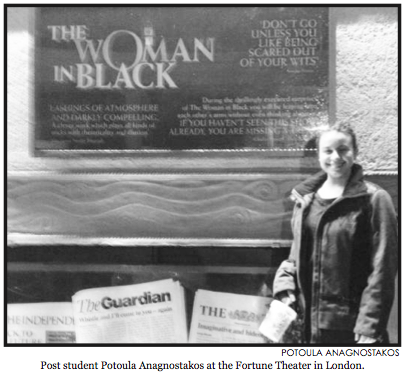By Potoula Anagnostakos
Staff Writer 
“The Woman in Black” tells the story of Arthur Kipps as he recalls his encounter with a malevolent spirit who haunts a secluded village along the English coast. Kips, a solicitor, had gone to settle the affairs of Mrs. Drablow, a recently deceased townswoman, when the figure of a gaunt young woman dressed in black appeared. When seen, there are consequences. Kipps tells his story to an actor, who convinces him to write down his experience. As they proceed to act out his past, Kipps begins to relive his nightmare. Adapted by Stephen Mallatratt from Susan Hill’s novel,
“The Woman in Black” is presented by PW Productions LTD., at the Fortune Theatre in Covent Garden, London. Robin Herford directed the play. I saw “The Woman in Black” on Jan. 31. My ticket was 35 pounds (roughly $58), placing me in the second row from the stage. Being so close, I felt as if I were part of the story, following Kipps relive the horrors of his past.
With a minimal set, props served for multiple purposes. A chest became a desk, a train seat and a bed. The pale grey curtains draped over furniture gave the stage an eerie glow under gloomy lights. Transparent fabric divided the stage in two; upstage houses the furniture belonging to Drablow, while downstage was the center of the house and other locations. The lights casted a dim glow onto the stage, which created a spectral ambiance. The costumes were from the early 20th century. The men wore suits of that time, while the woman in black wore an all-black mourning outfit.
A black veil concealed the woman’s face, but it then was removed to reveal her unsettling features. A paramount factor
of the production was the sound effects. They garnish the play’s haunting atmosphere. The sounds of a horrific horse and carriage accident blasted through the speakers, depicting the cause of the woman’s son’s death. Later on, the blood-curdling scream of the woman’s grief howled through the theatre, as the audience heard a mourning mother’s soul shattering.
Another crucial part of the show was the acting. The actors were very believable, and truly brought the characters and their stories to life. Every movement and every inflection was calculated and precise. Each step served a purpose, and each character had a distinguished walk and talk. Kipps, played by Stuart Fox, was
a quiet and reserved man. His voice was timid and his actions were hesitant. But Fox portrayed other characters in the play, seamlessly changing his voice, mannerisms, and costumes. The changes between the various parts were done incredibly well. Fox never stumbled, and he clearly distinguished his characters from one another.
The character of the Actor, played by Gwynfor Jones, was quite the opposite. He was energetic and exuded confidence. When playing Kipps as a young man, he completely transformed and discarded his grand hand gestures and sunny personality. He became the reserved Kipps, full of curiosity and determination, as someone ready to take on a new job. His confidence disintegrated once the woman in black maked an appearance. He became as frightened as Kipps was, cowering at the sight of this ghastly
figure. Fox and Jones worked very well together. They had wonderful chemistry, working off of each other’s energies. In addition, the actress who portrayed the title character was terrifying, and had such a powerful stage presence. She was menacing in her facial expressions and glared at her fellow actors in utter rage. She entered the stage in a very casual manner. Interestingly, the actress and the title character were not actually listed in the program, nor were they seen anywhere on the cast list, giving the illusion of a real ghost in the performance.
With these characters brought to the stage, the actions that followed caused a wonderful response from the audience. Each moment of suspense elicited a gasp, and every appearance of the ghostly woman made the audience shriek with fear and excitement. They gripped tightly the edges of their seats as Kipps moved through her haunting grounds. The show seemed to rely on the audiences’ reactions, playing off their fear. When the Actor as young Kipps goes to open a door, you expect the woman to be standing there. The anticipation, the excitement, the nervousness builds up tremendously, and the audience holds their breath, preparing themselves to see her. When it is a mere trick, the audience exhales with a sigh of enormous relief. Just as the worry subsides, she enters the stage for the briefest of moments. The element of suspense was consistently in the theatre’s atmosphere, and the story controlled it.
The Fortune Theatre is the perfect venue for this show. The story translated so well onto the stage. The stage is small but deep, allowing dimension to show different locations separated by the see-through fabric. The intimate space created by the auditorium and the stage space is very important to the show. There is an interactive feeling, with the actors entering stage through the audience. The audience was included in the show since the actors entered the stage through the audience. Also, since the woman’s surprise entrances are abrupt, they are more effective on a smaller stage, and the audience is right up against downstage. If it was done in a larger venue, the intimacy would disappear and it wouldn’t be as frightening. The audience could watch the story from afar and not feel involved. In the Fortune, audience members are right in the action.
In terms of actions or scenes, there weren’t any particular scenes that struck me; every moment struck me. Tension remained constant, so I was always on my toes. Overall, the show was excellent. It was frightening and exhilarating.



Be First to Comment